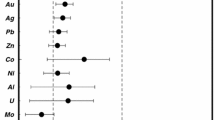Abstract
A loss distribution model is developed and applied to estimate the probabilities of finding enough new mineral deposits to meet demand, throughout the rest of this century, of the ten metals: Au, Ag, Cu, Mo, Pb, Zn, Ni, Co, Cr, and platinum-group elements (PGE). The model assumes that the necessary amount of metal exists in undiscovered mineral deposits and looks only at the probabilities of finding the required amount of metal in undiscovered resources. The probability density function that describes aggregate tonnage discovery over a specified period of time is the convolution of a mass density function that describes number of discoveries per unit time with a probability density function that describes deposit size distribution. Two alternatives for the deposit size distribution density function are used: pure lognormal or lognormal with a power-law upper tail, both taken from Patiño Douce (Nat Resour Res 25:365–387, 2016c). A Pascal (negative binomial) distribution is found to accurately reproduce number of yearly metal discoveries for the period 1950–2007, and is used to estimate future discovery probabilities. The convolution of the two functions is accomplished by means of a simple Monte Carlo method. Numerical experiments consisting of 106 iterations are used to estimate the aggregate tonnage most likely to be discovered until the year 2100, as well as the largest deposit most likely to be discovered over the same time period, together with confidence intervals for the two quantities. The results for Au, Ag, Zn, and Cu strongly suggest that serious shortages of these metals are likely to occur before the year 2100. At the other end of the spectrum, the models suggest that supplies of Mo and Co are not likely to become critical over that time frame. Ni and Pb occupy intermediate positions, and the results for Cr and PGE are inconclusive, chiefly owing to the large variability found in their deposit size distributions. Using a pure lognormal distribution versus a lognormal distribution with a power-law upper tail for deposit sizes does not affect these conclusions. The results do not prove nor disprove that the required amount of metal exists in undiscovered resources, but provide concrete actionable intelligence about the intensity of the exploration efforts needed to find the metal, if the deposits exist.











Similar content being viewed by others
References
Agterberg, F. (2016). Pareto-lognormal modeling of known and unknown metal resources. Natural Resources Research. doi:10.1007/s11053-016-9305-4
Chernoff, H. (1964). Estimation of the mode. Annals of the Institute of Statistical Mathematics, 16, 31–41.
Clauset, A., Shalizi, C. R., & Newman, M. E. J. (2009). Power-law distributions in empirical data. SIAM Review, 51, 661–703. doi:10.1137/070710111.
Heckman, P. E., & Meyers, G. G. (1983). The calculation of aggregate loss distribution from claim severity and claim count distributions. Proceedings of the Casualty Actuarial Society, 70, 22–61.
Johnson, K. M., Hammarstrom, J. M., Zientek, M. L., & Dicken, C. L. (2014). Estimate of undiscovered copper resources of the world, 2013. USGS Fact sheet 2014–3004.
Patiño Douce, A. E. (2016a). Metallic mineral resources in the twenty first century: I. Historical extraction trends and expected demand. Natural Resources Research, 25, 71–90. doi:10.1007/s11053-015-9266-z.
Patiño Douce, A. E. (2016b). Metallic mineral resources in the twenty first century: II. Constraints on future supply. Natural Resources Research, 25, 97–124. doi:10.1007/s11053-015-9265-0.
Patiño Douce, A. E. (2016c). Statistical distribution laws for metallic mineral deposit sizes. Natural Resources Research, 25, 365–387. doi:10.1007/s11053-016-9297-0.
Press, W. H., Flannery, B. P., Teukolsky, S. A., & Vetterling, W. T. (1990). Numerical recipes. The art of scientific computing. Cambridge: Cambridge University Press.
Schodde, R. (2010a). Global discovery trends 1950–2009: What where and who found them. http://www.minexconsulting.com/publications/mar2010b.html. Accessed May 12, 2016.
Schodde, R. (2010b). The declining discovery rate—What is the real story? http://www.minexconsulting.com/publications/mar2010a.html. Accessed May 12, 2016.
Shevchenko, P. V. (2010). Calculation of aggregate loss distributions. Journal of Operational Risk, 5, 3–40. doi:10.21314/JOP.2010.077.
Singer, D. A. (1995). World class base and precious metal deposits. A Quantitative Analysis. Economic Geology, 90, 88–104.
Singer, D. A. (2013). The lognormal distribution of metal resources in mineral deposits. Ore Geology Reviews, 55, 80–86.
Singer, D. A., & Kouda, R. (2011). Probabilistic estimates number of undiscovered deposits and their total tonnages in permissive tracts using deposit densities. Natural Resources Research, 20, 89–93.
Singer, D. A., & Menzie, W. D. (2010). Quantitative mineral resource assessments—An integrated approach. New York, NY: Oxford University Press.
USGS. (2015). Mineral commodity summaries. http://minerals.usgs.gov/minerals/pubs/mcs/2015/mcs2015.pdf
Acknowledgments
Thoughtful and thorough reviews by Frits Agterberg and an anonymous reviewer were most helpful in improving this manuscript and are gratefully acknowledged.
Author information
Authors and Affiliations
Corresponding author
Rights and permissions
About this article
Cite this article
Patiño Douce, A.E. Loss Distribution Model for Metal Discovery Probabilities. Nat Resour Res 26, 241–263 (2017). https://doi.org/10.1007/s11053-016-9315-2
Received:
Accepted:
Published:
Issue Date:
DOI: https://doi.org/10.1007/s11053-016-9315-2




